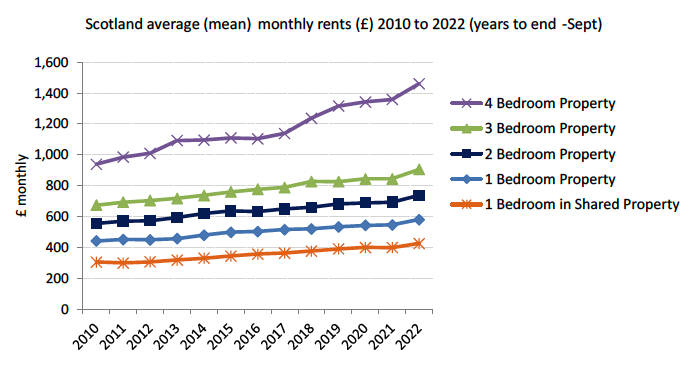Private Sector Rent Statistics, Scotland, 2010 to 2022
This publication presents statistics on average private sector rent levels in Scotland by Broad Rental Market Area and size of property, for the years 2010 to 2022.
8. Scotland-level Average Rents
Note that as with the previous publication, Scotland figures have been calculated using a weighted stock approach based on separate Scottish Household Survey data on the profile of stock by area and property size over time, although for this publication the weights used for the rental year 2020 have been rolled forward for the rental years 2021 and 2022 due to local authority level Scottish Household Survey figures being unavailable for these years.
The use of a weighted stock approach aims to help ensure that the national average figures presented reflect the underlying composition of private rental properites over time, and to minimise any effects of changes to sample numbers achieved for particular property sizes or areas in any given years.
| Broad Rental Market Area |
2010 |
2021 |
2022 |
2010 to 2022 change |
2021 to 2022 change |
|---|---|---|---|---|---|
| 1 Bedroom Property |
442 |
546 |
580 |
31.2% |
6.3% |
| 2 Bedroom Property |
554 |
693 |
736 |
32.9% |
6.2% |
| 3 Bedroom Property |
674 |
844 |
906 |
34.5% |
7.4% |
| 4 Bedroom Property |
939 |
1,358 |
1,460 |
55.6% |
7.5% |
| 1 Bedroom in Shared Property |
305 |
398 |
426 |
39.4% |
6.9% |

The greatest cumulative increase over the 12 years from 2010 to 2022 has been for 4 bedroom properties (estimated 55.6% increase). Average rents for 1 bedroom shared properties have seen a cumulative estimated increase of 39.4%, whilst average rents for 3 bedroom properties have increased by 34.5%, average rents for 2 bedroom properties have increased by 32.9%, and average rents for 1 bedroom properties have increased by 31.2%.
These cumulative increases equate to annualised growth rates of 2.3%, 2.4%, 2.5%, 3.8% and 2.8% for 1 to 4 bedroom and 1 bedroom shared properties respectively, when calculated on a compound annual increase basis between 2010 and 2022.
In the latest year, average rents are estimated to have risen by 6.3%, 6.2%, 7.4%, 7.5% and 6.9% for 1 to 4 bedroom and 1 bedroom shared properties respectively.
Summary of weighted stock methodology used in this publication:
Stock based weights for rented properties have been derived from Scottish Household Survey data, with the aim that this is to help ensure that the national average figures presented reflect any changes to the underlying composition of private rental properties over time, and to minimise any effects of changes to sample numbers achieved for particular property sizes or areas in any given years.
Weights for stock by Broad Rental Market Area have been built up by using an approximate mapping of local authority areas to Broad Rental Market Areas.
The weights from the survey data have been constructed using 3 year rolling data periods to help with precision of results at Broad Rental Market Area and to smooth out annual variations seen in the survey results. Each 3 year data period being centred on the rental year to be estimated with a lag applied of 2 years, due to the time delay between 3 year survey results being available and the latest rental year in question. For example, for the rental year 2020, a 3 year data period 2017 to 2019 has been used to construct the stock based weights, which equates to the year 2020 lagged by two years (i.e. to be centred on 2018).
One aspect to note for this publication is that given that the local authority level Scottish Household Survey results for the year 2020 and 2021 are not available, the previous set of weights based on the 3 year data period 2017 to 2019 have been rolled forward as the basis for the rental years 2021 and 2022.
For each property size category, the stock based weights are based on the proportion of private rented households in this category that are located in each of the Broad Rental Market Areas. These weights are then used as part of a weighted average calculation in constructing the Scotland level average rent estimates.
For example for 2 bedroom properties, if the 3 year survey data estimates that 10% of private rented properties of this size are located in a particular Broad Rental Market Area, then this 10% figure is multiplied by the average (mean) rental amount for this area when constructing the overall weighted average calculation.
The same methodology has been applied across all other property size categories, except for 1 bedroom shared properties where the weightings are instead based on the estimated proportions of owner occupier or private rented households in each areas that contain two or more adults who are not related or who are not in a married / civil partnership or a co-habiting partnership.
This aims to identify households where there may be an individual room being rented in some form. A combination of owner occupier and private rented households have been used as the basis for these weights given that individual rooms being rented are likely to be mix of lodger type situations where the tenure of the property is owner occupier with an individual room being rented out, along with private rented properties in which rooms may be rented out individually.
Contact
Email: housingstatistics@gov.scot
There is a problem
Thanks for your feedback